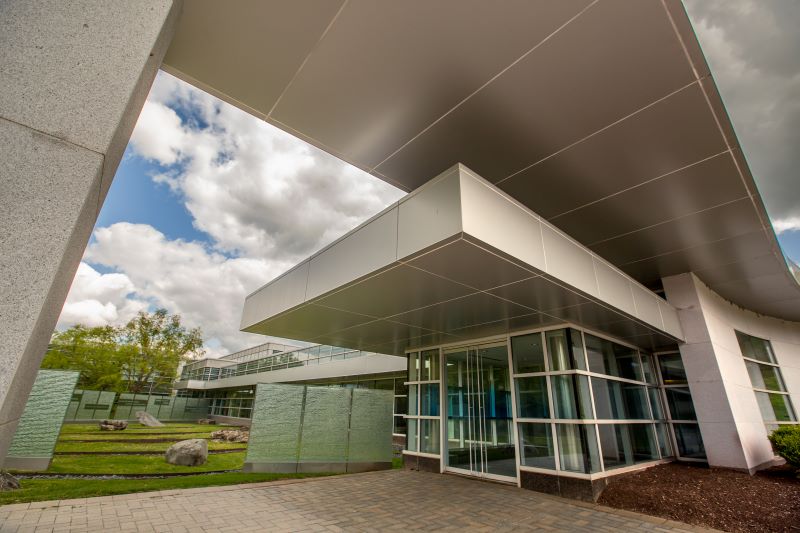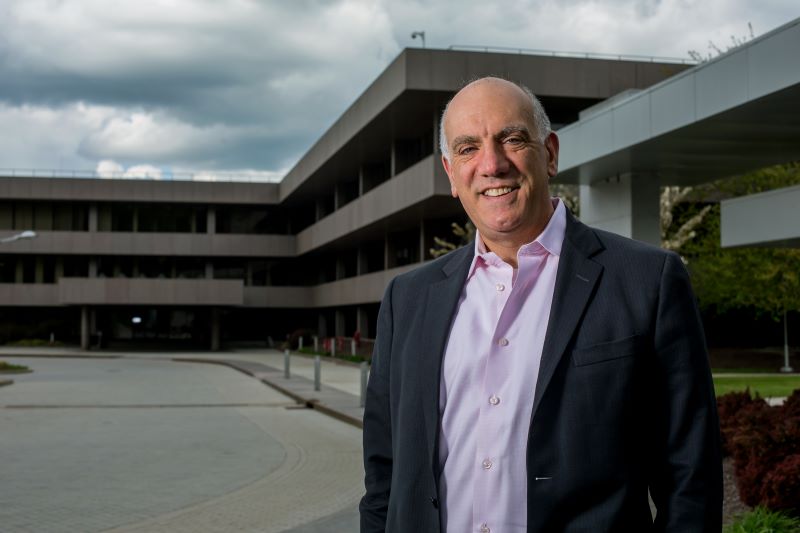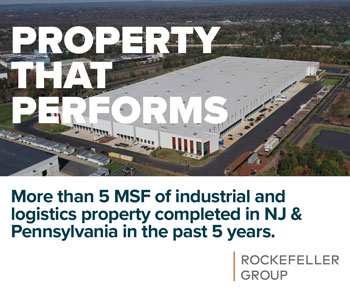Bedminster Mayor Larry Jacobs says the township has spent nearly a decade preparing for the possibility that AT&T would vacate its iconic 1.1 million-square-foot campus, its home of more than 45 years, culminating in a recent vote to rezone the 194-acre property near the junction of interstates 78 and 287. — Photo by Aaron Houston for Real Estate NJ
By Marlaina Cockcroft
Bedminster Township has spent eight years preparing for the possibility that AT&T would vacate its iconic 1.1 million-square-foot campus near the junction of interstates 78 and 287, culminating in in a recent vote to rezone the 194-acre property.
Now that the move is imminent, local officials are confident that their efforts will pay off.
“Our preference was that AT&T would stay and grow at the property,” Bedminster Mayor Larry Jacobs said. “But at the same time we had to recognize economic realities and corporate life in the 2020s and that these million-square-foot, single-user campuses may not be current for today’s mode of business.”
AT&T, which has occupied the site since 1977, announced last August that it would be relocating within Bedminster to the 233,000-square-foot former Mallinckrodt Pharmaceuticals building at 1405-1425 Route 206. Its lease at 1 AT&T Way expires in November — having sold the property to MetLife in 2006 — while a representative for the telecom giant noted that the move would begin at midyear but wouldn’t comment on the number of jobs in the new building.
Jacobs, a township resident for more than 25 years, has been working with MetLife and Somerset County officials to rezone the site to include life sciences, seeking to attract users in pharmaceuticals, medical devices and similar fields. The township committee adopted the new zoning late last year — even allowing for the potential of a complete redevelopment — and the mayor said the town has been getting inquiries from companies looking for life sciences buildings, primarily developers. He has also engaged the Economic Development Authority and other state agencies about finding incentives to bring in new tenants.

The process of repositioning the campus began even before Jacobs became mayor. While serving on the committee under Mayor Steven Parker, he and other officials observed other suburban, single-user campuses struggling to replace departing tenants — such as the former Merck & Co. facility in Readington, which was on the market from 2012 to 2018. They worried about something similar happening with AT&T, their largest taxpayer and biggest employer.As the former chair of the Urban Land Institute’s Northern New Jersey chapter — and as an environmental and land use attorney — Jacobs had experience with these issues.
“We decided that we needed to make sure that we kept our fingers on the pulse of what was going on with AT&T as well as with MetLife,” said Jacobs, who chairs the environmental law group at Wilentz, Goldman & Spitzer PA in Woodbridge. That meant looking at ways to keep the property in use if AT&T left.

Somerset County was able to help with this process. Walter Lane, director of the county Office of Planning, Policy and Economic Development, said the agency has provided redevelopment and planning assistance in most of the county’s municipalities.
The county identified the AT&T property as a “priority growth investment area” based on the County Investment Framework, which provides a “road map” of where growth or preservation should be encouraged, Lane said.
Using grant funding, Lane’s office worked with Bedminster officials to analyze the site and turn the recommendations into new zoning.
Jacobs — who was mayor by this point — said they wanted to maintain an employment base that would fit the demographics of the area. Life sciences and high-tech businesses are consistent with the types of jobs that AT&T offers as well as the pharmaceutical industry offerings throughout the region, he said.
Knowing that AT&T was downsizing nationwide, “it became apparent to me that they were going to leave” and that Bedminster needed the new zoning in place, he said.
“We’re certainly happy that they did stay in Bedminster,” Jacobs said. He hasn’t heard anything about job losses, but noted that AT&T’s new site offers more flexibility as remote work continues post-COVID-19. The property “had recently just been completely refurbished by Mallinckrodt to a much more modern layout, de-emphasizing offices and separate rooms and (is) much more accommodating to the modern style of ‘Pick up your computer, go find a desk and start working.’”
The AT&T representative said: “We routinely evaluate our real estate portfolio and adjust it as needed to align with the needs of our customers and the business. We’re moving the work currently done at 1 AT&T Way to another facility in Bedminster, because our lease is expiring. We will continue to have a presence in Bedminster and we remain committed to New Jersey.”
When the company’s current site was chosen in the ’70s, Jacobs said, it was designed to be isolated and secure. Today’s life sciences or research campuses need different features, like co-locating with other companies and having amenities within walking distance. That’s why the site is zoned for 2 million square feet, of which 300,000 is available for a conference center hotel and amenities like a fitness center, restaurants or retail.
There’s already residential nearby, so “we could essentially create a live, work and play environment at the property, at the same time taking a campus that had been isolated — unless you worked there, you drove by the facility and never even knew that it existed — and now it conceptually would be open.” Amenities would be available to the public, Jacobs said.
Unlike this site, the Verizon campus in Basking Ridge — also a former AT&T site — appears to have changed previously announced plans to add housing, retail and amenities.
“Basking Ridge is a highly amenitized campus for our employees,” a Verizon representative said. “Given the changes to our workstyle since COVID, we do not see a pressing need for retail or residential on our campus at this time.”
Instead, the project that inspired Jacobs was Bell Works, the repurposed former Bell Labs campus in Holmdel, which now includes restaurants, shops and other public spaces.
Jacobs isn’t sure whether the AT&T buildings can be reused or repurposed as Bell Works was. “Our zoning certainly envisions that those buildings will be gone and that someone will essentially get a clean slate to work around the zoning we’ve put in place,” he said.

Towns are increasingly trying to determine options for single-user sites like this, said Peter Kasabach, executive director of New Jersey Future, the smart growth advocacy organization. Rural sites can be difficult to reuse, but one with infrastructure in a growth area can be a good candidate for redevelopment.
“There’s a whole spectrum,” Kasabach said. “In some cases, and AT&T might fall into this top end, where it’s a really good facility, it can just be repurposed and reused for multiple users instead of one user … The other end of the spectrum is, it’s really obsolete, you’re not going to want to keep it as commercial, and it creates an opportunity to create … a different kind of asset for the community, where you can introduce a street grid, you can have mixed uses, you can have housing with commercial. You make connections between the site and the rest of the town.”
Jacobs would like to see tenants in the AT&T site as soon as possible. And he has some advice for towns facing a stranded asset situation.
“It’s never too soon to start planning,” he said.
Marlaina Cockcroft is a freelance writer based in New Jersey. She has also written for School Library Journal, New Jersey Monthly and Best of NJ, and previously wrote about real estate for The Record newspaper.










